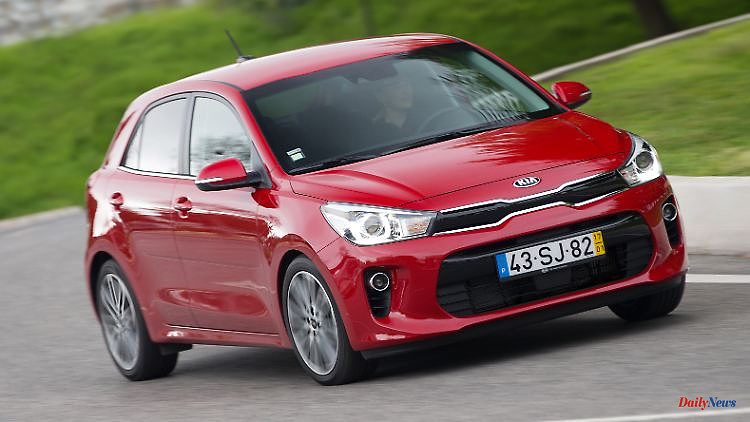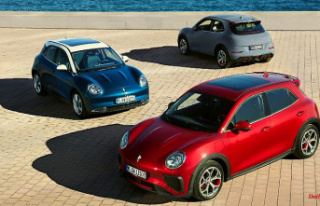Used small cars have become expensive. This also applies to the Kia Rio. It's good that the little one knows how to convince otherwise. However, it is usually not cheap as a used one.
The Kia Rio has been on the German market since 2000, meanwhile since the beginning of 2017 in the fourth generation (type YB). The current generation of the small car has already passed two main TÜV inspections. The question remains how the little Korean did there.
body and interior
The Kia Rio stretches to a length of 4.07 meters. The small car, which is only available as a five-door hatchback, offers good space. The trunk volume is 325 liters, if you fold down the rear seat backrest, around 1100 liters are available for loading. Thanks to the rear seat backrest, which can be folded down in two parts, a level luggage compartment is created, since a removable intermediate floor in the trunk equalizes the difference in height to the passenger compartment and at the same time minimizes the height of the loading threshold to a few centimetres. Visually, the Rio conveys self-confidence with clear lines and crisp proportions. He looks grown up. The cockpit is clearly laid out, the interior looks dignified, at least in the higher equipment versions.
In the fall of 2020, the small car received a facelift. Among other things, the air vents in the lower front apron were worked out more plastically and the fog lights were modified.
engines and propulsion
At the market launch, Kia offered four petrol engines and one diesel for the Rio. The latter, a 1.4-liter with 66 kW/90 hp and 240 Nm, was dropped from the program in mid-2018. The entry-level petrol engine is a 1.2-liter four-cylinder - until 2020 with 1248 cubic centimeters, since then with 1197 - that delivers 62 kW/84 hp. Like the 1.4 liter with 73 kW/99 hp, the 1.2 does without turbo support. Both engines need diligent shifting to get up to speed. A manual six-speed gearbox is available for the more powerful version, the 84 hp engine has to make do with one gear less. Both engines achieve a top speed in excess of 170 km/h (173 and 175 km/h), the sprint from 0 to 100 km/h takes 12.9 and 12.2 seconds respectively.
Kia specifies values of around 5 liters as average consumption. If you are looking for an automatic, you have to go for the 1.4. A four-speed automatic could be ordered for the 1.4 available until mid-2019.
If you appreciate a little more liveliness, you can go for the one-liter three-cylinder, which is available in two configurations with 74 kW/100 hp and 88 kW/120 hp. The turbo mobilizes 172 Nm in both variants, the suckers only reach 122 and 133 Nm. The top speed is reached at Tempo 188 and 190. Even with the three-cylinders, the weaker version has to make do with a five-speed switch; the 120 hp engine is factory-fitted with a manual six-speed gearbox, and a seven-speed dual-clutch gearbox (DSG) is available as an option. Kia specifies values between 4.5 and 5.3 liters as consumption.
In the course of the facelift, the small turbo with 100 hp can also be combined with DSG. The top version now has a fuel-saving 48-volt mild hybrid system on board.
equipment and security
The Rio was initially offered in the typical Kia equipment lines Attract, Edition 7, Spirit, GT Line and Platinum Edition. The basic variant Attract comes with an on-board computer, light sensor and radio with USB connection, among other things, but first-time buyers had to book air conditioning. At the upper end of the comfort level, "Platinum Edition" offers almost everything a small car driver's heart desires, including a 17-inch model, automatic air conditioning, seat and steering wheel heating, navigation system, parking sensors and reversing camera. When it comes to connectivity, the Rio can keep up in the high-end lines. Starting with "Spirit", many assistants also come as standard. They are optionally available for the lower lines. In the context of the facelift, Kia has streamlined the supply structure. The lowest equipment lines have been omitted. The 2017 Rio scored five stars in the NCAP crash test.
quality
Unlike the previous generation, the current Rio has so far not made any mistakes in the main TÜV inspections. The test points chassis and brakes, weak points of the third generation, he masters without errors or almost without errors (brake system). As before, the lighting system is a small weak point. Interested parties should take a close look here. When purchasing a used Rio, buyers also benefit from the 7-year guarantee that Kia grants on new cars and that is transferred to the new owner when the used car is sold. It still applies to older, fourth-generation vehicles.
Conclusion: Thanks to the guarantee and its solid performance at the TÜV, used car buyers of a current Rio model don't do much wrong. However, they have to dig deep into their pockets. At least 10,000 euros are due for a used copy.












